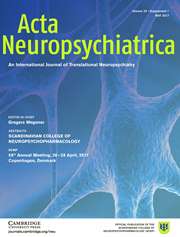No CrossRef data available.
Article contents
Structural Brain Variability in Recent-Onset and Chronic Schizophrenia: Evidence from Person-Based Similarity Index Analysis
Published online by Cambridge University Press: 03 November 2025
Abstract
Structural abnormalities in cortical and subcortical brain regions are consistently observed in schizophrenia; however, substantial inter-individual variability complicates identifying clear neurobiological biomarkers. The Person-Based Similarity Index (PBSI) quantifies individual structural variability; however, its applicability across schizophrenia stages remains unclear. This study aimed to compare cortical and subcortical structural variability in recent-onset and chronic schizophrenia and explore associations with clinical measures.
Neuroimaging data from 41 patients with recent-onset schizophrenia, 32 with chronic schizophrenia, and 59 healthy controls were analyzed. The PBSI scores were calculated for cortical thickness, surface area, cortical gray matter volume, and subcortical volumes. Group differences in PBSI scores were assessed using linear regression and analysis of variance. Correlations between the PBSI scores and clinical measures were also examined.
Both patients with recent-onset and chronic schizophrenia exhibited significantly lower PBSI scores than healthy controls, indicating greater morphometric heterogeneity. However, significant differences between the recent-onset and chronic patient groups were limited to subcortical and cortical thickness PBSI scores. Correlations between PBSI scores and clinical symptoms are sparse and primarily restricted to surface area variability and symptom severity in patients with recent-onset schizophrenia.
Patients with schizophrenia show marked structural brain heterogeneity compared with healthy controls, which is detectable even in the early stages of the illness. Although there were few differences in PBSI scores between the recent-onset and chronic schizophrenia groups and limited correlations between PBSI scores and clinical measures, the PBSI may still provide valuable insights into individual differences contributing to clinical heterogeneity in schizophrenia.
Information
- Type
- Original Article
- Information
- Creative Commons
- This is an Open Access article, distributed under the terms of the Creative Commons Attribution licence (http://creativecommons.org/licenses/by/4.0/), which permits unrestricted re-use, distribution and reproduction, provided the original article is properly cited.
- Copyright
- © The Author(s), 2025. Published by Cambridge University Press on behalf of Scandinavian College of Neuropsychopharmacology

